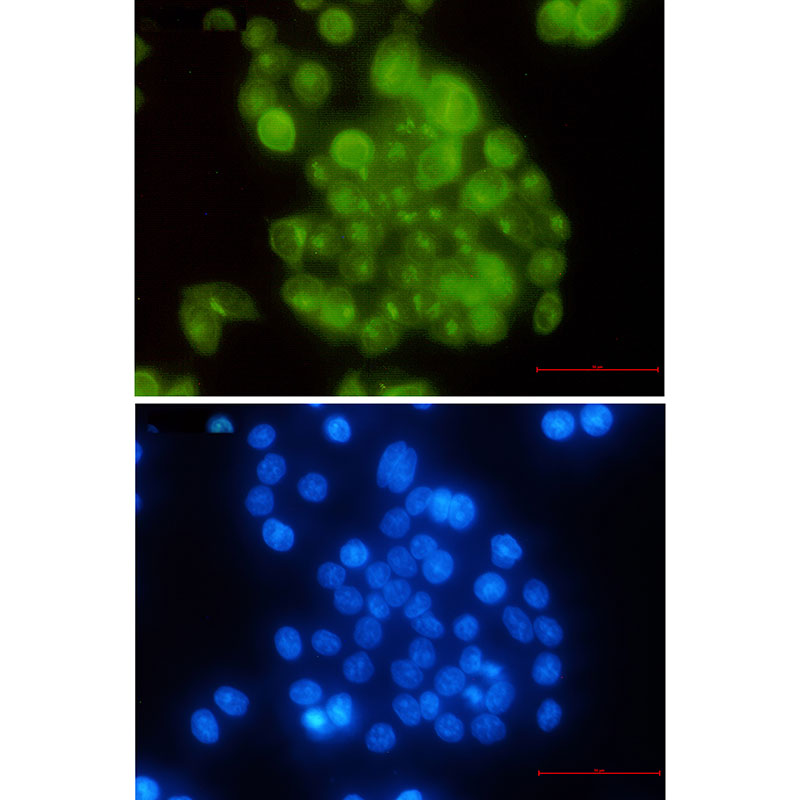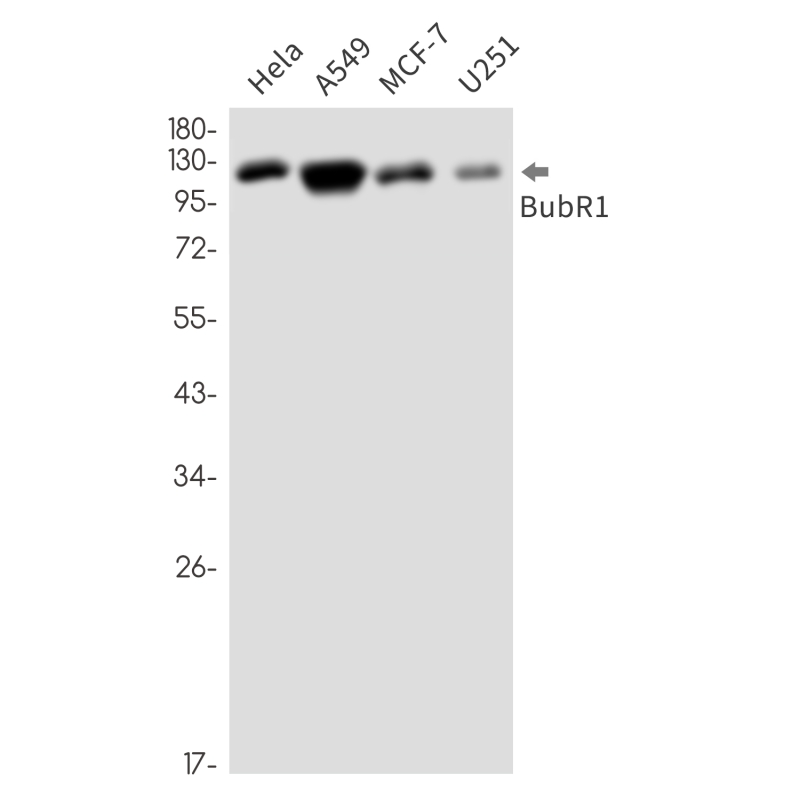

| WB | 1/500-1/1000 | Human,Mouse,Rat |
| IF | 1/20 | Human,Mouse,Rat |
| IHC | 咨询技术 | Human,Mouse,Rat |
| ICC | 1/50-1/200 | Human,Mouse,Rat |
| FCM | 咨询技术 | Human,Mouse,Rat |
| Elisa | 咨询技术 | Human,Mouse,Rat |
| Aliases | BUB1B; BUBR1; MAD3L; SSK1; Mitotic checkpoint serine/threonine-protein kinase BUB1 beta; MAD3/BUB1-related protein kinase; hBUBR1; Mitotic checkpoint kinase MAD3L; Protein SSK1 |
| Entrez GeneID | 701 |
| WB Predicted band size | Calculated MW: 120 kDa; Observed MW: 120 kDa |
| Host/Isotype | Rabbit IgG |
| Antibody Type | Primary antibody |
| Storage | Store at 4°C short term. Aliquot and store at -20°C long term. Avoid freeze/thaw cycles. |
| Species Reactivity | Human |
| Immunogen | A synthetic peptide of human BubR1 |
| Formulation | Purified antibody in TBS with 0.05% sodium azide,0.05%BSA and 50% glycerol. |
+ +
以下是关于BUBR1抗体的3篇代表性文献,内容简明概括:
---
1. **文献名称**:*BubR1 insufficiency causes early onset of aging-associated phenotypes and infertility in mice*
**作者**:Baker DJ, et al.
**摘要**:该研究利用BUBR1抗体检测基因敲除小鼠模型,发现BUBR1蛋白水平降低会导致染色体分离错误、早衰表型(如肌肉萎缩、白内障)及生育力下降,提示BUBR1在维持基因组稳定性和延缓衰老中的关键作用。
---
2. **文献名称**:*The role of Bub1 in the spindle assembly checkpoint*
**作者**:Lara-Gonzalez P, et al.
**摘要**:通过免疫沉淀和Western blot结合BUBR1抗体,研究揭示了BUBR1与BUB1在有丝分裂检查点中的协同作用,证明其通过调控CDC20活性阻止染色体过早分离,确保细胞分裂精确性。
---
3. **文献名称**:*BubR1 expression is correlated with tumor progression in colorectal cancer*
**作者**:Park HJ, et al.
**摘要**:利用BUBR1抗体对结直肠癌组织进行免疫组化分析,发现BUBR1高表达与肿瘤分期、转移及预后不良显著相关,提示其可作为潜在癌症生物标志物或治疗靶点。
---
**备注**:以上文献均发表于《Nature》《Genes & Development》等期刊,实验方法中明确使用BUBR1抗体进行蛋白定位、定量或功能研究。如需具体年份或PMID可进一步补充。
BUBR1 (BUB1B) is a critical component of the spindle assembly checkpoint (SAC), a surveillance mechanism ensuring accurate chromosome segregation during mitosis. It functions as a kinase and scaffold protein, coordinating interactions between SAC components to delay anaphase until all chromosomes achieve proper microtubule attachment and tension. BUBR1 also monitors kinetochore-microtubule stability, preventing errors that could lead to aneuploidy, a hallmark of genomic instability linked to cancer and age-related disorders.
Antibodies targeting BUBR1 are widely used to study its expression, localization, and post-translational modifications in diverse biological contexts. These tools enable detection via techniques like Western blotting, immunofluorescence, and immunoprecipitation, aiding research on cell cycle regulation, cancer biology, and aging. For example, reduced BUBR1 levels correlate with premature aging in mouse models, while mutations are implicated in mosaic variegated aneuploidy syndrome, a human disorder characterized by developmental defects and cancer predisposition.
Commercial BUBR1 antibodies vary in specificity, often validated in model organisms (e.g., human, mouse), and require careful optimization to avoid cross-reactivity with paralogs like BUB1. Their applications extend to diagnostic research, particularly in cancers with SAC dysfunction, and therapeutic studies targeting mitotic fidelity. Despite challenges in antibody validation, BUBR1 remains a key biomarker for probing mitotic errors and their pathological consequences.
×